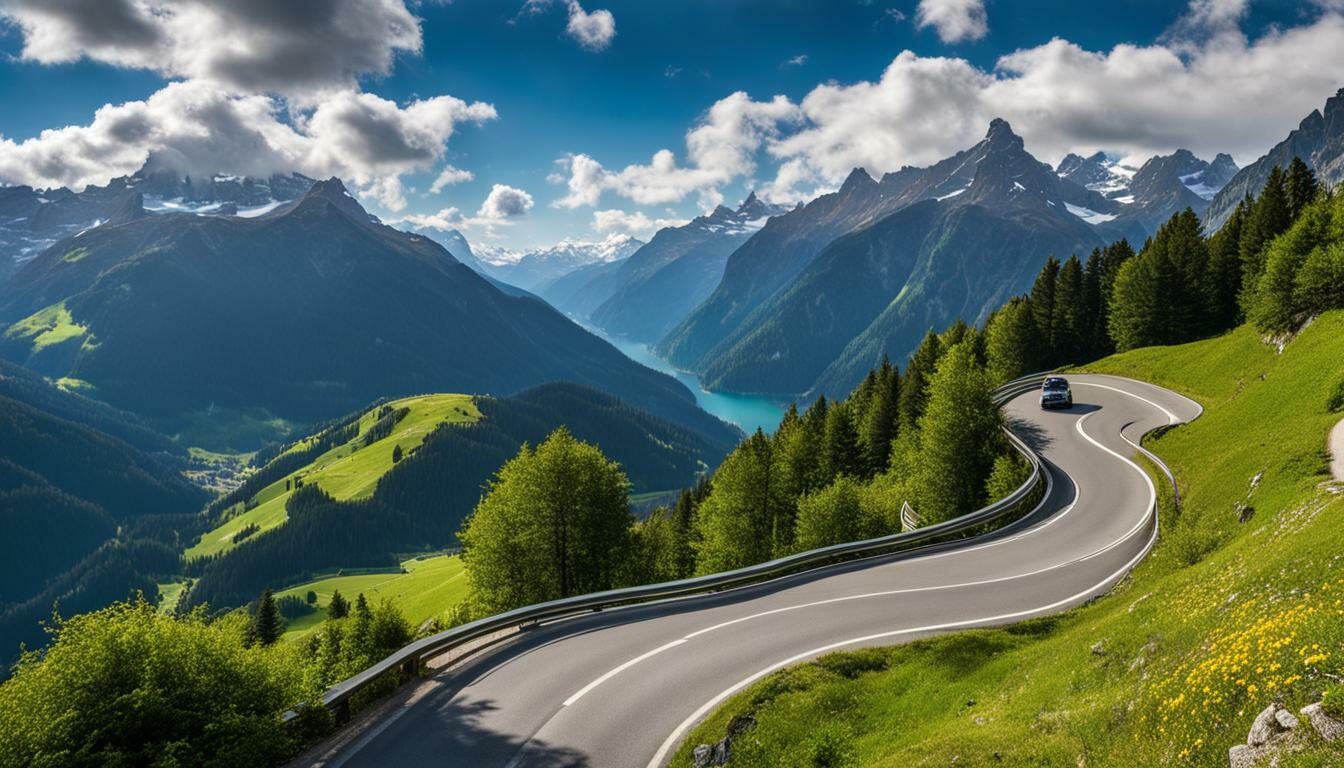Are you ready to embark on an unforgettable adventure behind the wheel in Switzerland? Driving in this picturesque country offers a unique experience that allows you to explore its breathtaking landscapes and charming towns at your own pace. However, it's important to familiarize yourself with the rules and regulations to ensure a safe and enjoyable journey.
Key Takeaways:
- Drive on the right-hand side of the road in Switzerland.
- Give priority to traffic coming from the right, unless there is a priority sign.
- Carry a warning triangle and a fluorescent jacket for breakdowns or accidents.
- Adhere to a blood alcohol limit of 0.5% and anticipate random breath tests.
- Follow specific rules for driving in the mountains, such as giving uphill drivers priority.
Navigating Swiss Roads
Before hitting the road, familiarize yourself with Swiss driving regulations and be mindful of road signs and speed limits. When driving in Switzerland, you need to drive on the right-hand side of the road and give priority to traffic coming from the right, unless there is a priority sign. It is mandatory to carry a warning triangle and a fluorescent jacket in case of breakdowns or accidents. Safety is of utmost importance, and random breath tests are conducted to ensure that drivers are not under the influence of alcohol.
When driving in the mountains, it is important to be cautious and follow the local rules. Uphill drivers have priority, and it is recommended not to brake excessively on steep roads to prevent overheating of the brakes. Especially in Alpine regions, snow chains and winter tires are recommended between October and April to ensure your safety on icy or snowy roads. To enhance visibility, keep your headlights on at all times, regardless of the weather conditions. Remember to fasten your seat belts, as they are mandatory for both the driver and passengers.
Speed limits vary depending on the type of road you are driving on, so it's important to pay attention to the speed limit signs. Exceeding the speed limit can result in high fines. When driving on Swiss freeways, known as autoroutes, a motorway tax sticker called a vignette is required. You can purchase this vignette at border crossings, gas stations, or post offices. Staying overnight in a car on a public parking lot is generally not permitted, so it's important to plan your accommodations accordingly.
| Driving Regulations | Road Signs | Speed Limits |
|---|---|---|
| Drive on the right-hand side of the road. | Pay attention to road signs, such as stop signs, give way signs, and speed limit signs. | Speed limits vary depending on the type of road: – Urban areas: 50 km/h (31 mph) – Rural areas: 80 km/h (50 mph) – Expressways: 100 km/h (62 mph) – Freeways: 120 km/h (75 mph) |
| Give priority to traffic coming from the right, unless there is a priority sign. | Be aware of road signs indicating dangerous curves, inclines, or road conditions. | Always adhere to the posted speed limits to avoid fines and ensure your safety. |
| Carry a warning triangle and a fluorescent jacket in case of breakdowns or accidents. | Follow road signs that indicate parking restrictions, pedestrian crossings, and other important information. |
By following the Swiss driving regulations, being mindful of road signs, and respecting the speed limits, you can have a safe and enjoyable driving experience in Switzerland. Remember to plan your route, keeping in mind any specific rules or requirements for driving in the area you will be visiting. Take the time to familiarize yourself with the local traffic rules and be prepared for various road conditions. Whether you are exploring the picturesque Swiss countryside or navigating through bustling city streets, responsible and attentive driving will ensure a memorable journey in Switzerland.
Safety First: Driving Permit and Safety Precautions
Ensuring you have a valid driving permit and taking necessary safety precautions are essential for a smooth and secure driving experience in Switzerland. Before hitting the road, make sure you possess a valid driving permit that is recognized in Switzerland. For visitors from most countries, an international driving permit is sufficient, along with your regular driver's license. However, some countries require an additional Swiss translation of their driving permit, so it's important to check the specific requirements before your trip.
Once you have the necessary documents in hand, it's time to prioritize safety. Switzerland has strict rules governing driving behavior and it is crucial to respect them. One important safety precaution is to always wear your seat belt, as it is mandatory for both drivers and passengers. Additionally, it is crucial to keep your headlights on at all times, even during the day, to enhance visibility and ensure other drivers can see you on the road.
When it comes to alcohol consumption, it is important to note that the blood alcohol limit in Switzerland is 0.5%. Random breath tests are conducted, so it's advisable to avoid drinking and driving altogether. To be prepared for any unforeseen circumstances, it is mandatory to carry a warning triangle and a fluorescent jacket in your vehicle. These items can be life-saving in the event of a breakdown or accident, so make sure they are easily accessible in your car.
| Driving Permit Requirements | Safety Precautions |
|---|---|
| An international driving permit is generally sufficient, but check the specific requirements for your country. | Always wear your seat belt, and keep your headlights on at all times. |
| Some countries may require an additional Swiss translation of their driving permit. | Avoid drinking and driving, and carry a warning triangle and a fluorescent jacket. |
By following these driving permit and safety precautions, you can enjoy the stunning Swiss landscapes and navigate the roads with confidence. Remember, safety should always be your top priority, so stay alert, be considerate of other drivers, and adhere to the rules and regulations of the road. Safe travels!
Understanding Local Traffic Rules
Get acquainted with the intricacies of local traffic rules in Switzerland, from priority to uphill driving in the mountains. When driving in Switzerland, it's important to familiarize yourself with the specific rules and regulations to ensure a safe journey.
Priority to Traffic from the Right
In Switzerland, drivers must give priority to traffic coming from the right, unless there is a priority sign indicating otherwise. This means that when approaching intersections or junctions without priority signs, you must yield the right of way to vehicles approaching from your right. It's essential to be vigilant and cautious, especially in urban areas and when navigating busy intersections.
Driving in the Mountains
Driving in the mountainous regions of Switzerland requires extra caution and adherence to local rules. Uphill drivers have the right of way, and downhill drivers must yield when passing on narrow roads. Additionally, it is recommended not to brake excessively on steep descents to prevent overheating of the brakes. In snowy or icy conditions, it is essential to use snow chains and winter tires, particularly between October and April, to ensure optimal traction and control.
| Driving Tips for Switzerland's Mountains |
|---|
| Uphill drivers have right of way |
| Brake cautiously on steep descents |
| Use snow chains and winter tires in snowy conditions |
By following these rules, you can navigate the challenging road conditions in the Swiss mountains more safely and enjoy the mesmerizing landscapes that this country has to offer.
Navigating Challenging Road Conditions
Brace yourself for challenging road conditions in Switzerland, especially in the alpine regions, and learn how to navigate them with confidence. Whether you're planning a scenic drive through the picturesque Swiss Alps or heading to a winter resort, understanding the road conditions and taking necessary precautions is crucial for a safe journey.
In the alpine regions, you may encounter narrow and winding roads, steep gradients, and unpredictable weather conditions. Snow, ice, and fog can make driving more difficult, so it's essential to be prepared. Between October and April, it is highly recommended to have snow chains and winter tires, especially in the mountainous areas where they may be required by law. These precautions provide better traction and control on slippery surfaces, ensuring a safer drive.
Additionally, when driving on mountainous roads, it is important to be mindful of local rules. Uphill drivers generally have priority, so be prepared to yield if necessary. Avoid excessive braking on steep descents to prevent overheating of the brakes. Keeping your headlights on at all times enhances visibility, especially during inclement weather or in tunnels.
| Road Condition | Recommended Precautions |
|---|---|
| Snow/Ice | Use snow chains and winter tires. Drive at a reduced speed and increase braking distance. |
| Fog | Reduce speed, use fog lights if available, and increase distance from the vehicle in front. |
| Steep Gradients | Be cautious, especially when descending. Avoid excessive braking to prevent overheating of the brakes. |
| Unpredictable Weather | Check weather forecasts before setting off. Be prepared for sudden changes and exercise caution. |
To ensure a smooth drive, always follow the speed limits indicated on road signs. Speeding fines in Switzerland can be high, and strict enforcement of traffic laws is in place. Adhering to the designated speed limits increases safety for yourself and others on the road.
Remember, the key to navigating challenging road conditions in Switzerland is to be well-prepared, knowledgeable, and attentive. By following the local regulations, equipping your vehicle with the necessary gear, and adopting a cautious approach, you can enjoy the breathtaking Swiss landscapes and embark on a memorable driving adventure.
Coping with Traffic Congestion
Don't let traffic congestion dampen your driving experience in Switzerland – discover tips and tricks to stay ahead of the rush. As a popular tourist destination and a bustling country with vibrant cities, Switzerland is no stranger to traffic congestion. However, with a little planning and some insider knowledge, you can navigate the traffic jams with ease.
- Plan ahead: Before embarking on your journey, it's crucial to check for any potential traffic congestion along your route. You can use online maps or GPS applications that provide real-time traffic updates. This way, you can choose alternative routes or adjust your travel time to avoid peak traffic hours.
- Consider public transportation: If you find yourself in an area notorious for heavy traffic, it may be worth considering using public transportation instead. Switzerland boasts an excellent public transport network, including trains, trams, and buses, which can often be a faster and more convenient option during peak hours.
- Take advantage of carpooling: Carpooling is a great way to not only reduce traffic congestion but also share travel costs. You can join carpooling platforms or arrange rides with friends or colleagues who are traveling in the same direction. Not only will you help alleviate traffic, but you might also make new friends along the way!
- Stay informed: Traffic conditions can change rapidly, especially during peak travel seasons or in urban areas. Stay updated by tuning in to local radio stations that provide traffic reports or checking social media channels for real-time updates from fellow drivers. Having the latest information will help you make informed decisions and avoid unnecessary delays.
Remember, patience is key when dealing with traffic congestion. Take advantage of the opportunity to enjoy the scenic views Switzerland has to offer, listen to your favorite podcast or music playlist, and remain calm behind the wheel. By following these tips and tricks, you'll be well-prepared to tackle traffic congestion and enjoy a smooth driving experience in Switzerland.
Table: Common Causes of Traffic Congestion in Switzerland
| Cause | Description |
|---|---|
| Road construction | Switzerland is known for its meticulous road maintenance, which can sometimes cause temporary lane closures and diversions. |
| Tourist influx | During peak tourist seasons, popular destinations can become congested with both local and international travelers. |
| Accidents | Collisions or breakdowns on major roads can quickly lead to traffic backups, especially during busy travel times. |
| Urban congestion | Cities like Zurich, Geneva, and Bern experience heavy traffic due to their high population density and business centers. |
Practical Tips for a Smooth Drive
Ensure a hassle-free drive in Switzerland with practical tips, including acquiring a motorway tax sticker and adhering to parking regulations. These tips will help you navigate Swiss roads confidently and make the most of your driving experience.
Acquiring a Motorway Tax Sticker
When driving on Swiss freeways, known as Autobahns, it is important to have a motorway tax sticker, also known as a vignette, displayed on your windshield. This sticker allows you to use the country's extensive network of highways without any additional charges. The vignette is valid for one calendar year and can be purchased at border crossings, gas stations, or post offices. Make sure to affix the sticker correctly on your windshield as failure to display it properly can result in fines.
Adhering to Parking Regulations
It is essential to familiarize yourself with parking regulations in Switzerland. Staying overnight in a car on a public parking lot is generally not permitted. However, some designated parking areas or camping sites may allow overnight stays. Be sure to check local signage and consult with authorities if you plan on sleeping in your car. Additionally, pay attention to parking signs and follow the designated parking zones to avoid fines. In some cities, such as Zurich and Geneva, parking can be expensive, so it may be more convenient to use public transportation instead.
Other Considerations
While driving in Switzerland, always fasten your seat belts and keep your headlights on, even during the day. Seat belt usage is mandatory for both the driver and passengers. The use of mobile phones while driving is strictly prohibited unless you have a hands-free system. It is advisable to carry cash as some toll booths and parking meters may not accept credit cards. Finally, be mindful of speed limits, which vary depending on the road type. Fines for speeding can be steep, so it's crucial to adhere to the posted limits.
| Tips for a Smooth Drive in Switzerland |
|---|
| Acquire a motorway tax sticker (vignette) to use Swiss freeways without additional charges. |
| Familiarize yourself with parking regulations and avoid staying overnight in a car on public parking lots. |
| Always fasten seat belts, keep headlights on, and refrain from using mobile phones while driving. |
| Carry cash for toll booths and parking meters that may not accept credit cards. |
| Observe speed limits and avoid speeding to prevent fines. |
By following these practical tips, you can enjoy a stress-free and safe driving experience in Switzerland. Remember to respect the rules and regulations, and take in the breathtaking landscapes as you explore this beautiful country behind the wheel.
Conclusion
Embarking on a driving adventure in Switzerland can be an incredible experience if you adhere to the rules and regulations, ensuring a safe and unforgettable journey. When driving in Switzerland, it's important to remember that you drive on the right-hand side of the road and give priority to traffic coming from the right, unless there is a priority sign. This basic rule helps maintain order and safety on the roads.
Additionally, make sure to carry a warning triangle and a fluorescent jacket in case of breakdowns or accidents. These items are mandatory and can greatly assist in ensuring your safety and the safety of others. Swiss authorities also conduct random breath tests to enforce the blood alcohol limit of 0.5%, so it's important to abstain from drinking and driving.
When driving in the mountains, be cautious and follow the local rules. Uphill drivers have priority, and it's recommended not to brake excessively on steep roads to prevent overheating of the brakes. Between October and April, snow chains and winter tires are highly recommended, especially in Alpine regions, where road conditions can be challenging due to snow and ice.
Remember to keep your headlights on at all times and fasten your seat belts. Speed limits vary depending on the road type, and fines for speeding are high. If you plan on driving on Swiss freeways, don't forget to purchase a motorway tax sticker, known as a vignette, to comply with the regulations. You can obtain the vignette at border crossings, gas stations, or post offices. Finally, be aware that staying overnight in a car on a public parking lot is generally not permitted.
To make the most of your driving experience in Switzerland, respect the rules, drive responsibly, and enjoy the breathtaking beauty of the country at your own pace. Happy travels!
FAQ
Are there any specific rules for driving in Switzerland?
Yes, in Switzerland, you drive on the right-hand side of the road and must give priority to traffic coming from the right, unless there is a priority sign. It is also mandatory to carry a warning triangle and a fluorescent jacket in case of breakdowns or accidents. The blood alcohol limit is 0.5%, and random breath tests are conducted.
What should I know about driving in the mountains in Switzerland?
When driving in the mountains, it is important to be cautious and follow the local rules. Uphill drivers have priority, and it is recommended not to brake excessively on steep roads to prevent overheating of the brakes. Snow chains and winter tires are recommended between October and April, especially in Alpine regions. It is also important to keep your headlights on at all times and fasten seat belts.
What are the speed limits in Switzerland?
Speed limits vary depending on the road type. In urban areas, the speed limit is usually 50 km/h, while on rural roads it is 80 km/h. On dual carriageways, the limit is 100 km/h, and on motorways, it is 120 km/h. It's important to note that fines for speeding are high in Switzerland.
Do I need a motorway tax sticker to drive on Swiss freeways?
Yes, when driving on Swiss freeways, a motorway tax sticker called a vignette is required. You can purchase the vignette at border crossings, gas stations, or post offices. Make sure to display it on your windshield to avoid fines.
Can I stay overnight in my car on a public parking lot in Switzerland?
Generally, staying overnight in a car on a public parking lot is not permitted in Switzerland. It is advisable to find proper accommodation for overnight stays.



